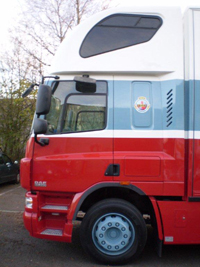Is it a boat or a truck? We’ll it’s a truck with a boat tail, the new technology that tests have shown to reduce fuel consumption by 7.5%. GB Liners has recently taken delivery of its first boat-tail vehicles. Here’s why …
In the last 12 months, Hereford-based GB Liners has invested in a new fleet of boat-tail vehicles that will, if the research is proved right, reduce fuel consumption by around 7.5%.

It was back in 2009 that Robert Bartup from GB Liners started looking at practical ways of reducing fuel consumption. After much consideration he placed an order with DAF dealer Watts Trucks for two 10 ton DAF 45’s, two 14 ton, DAF 55 and three DAF 65’s. All seven vehicles were delivered to Unique Van Bodies of Warrington to be fitted with the potentially revolutionary ‘Airmover’ design of body. One key requirement was that the vehicles must maintain GB Liners’ container and cube specification across the different vehicle weights.
Tests carried out by PART (Platform for Aerodynamic Road Transport) in The Netherlands, have showed that boat-tail vehicles have the ability to save between 7.5% and 15% of fuel. The tests were carried out with an existing vehicle with a bolt on rear tapering protrusion, wind tunnels and computer aids. The vehicle was driven for a full year with a boat-tail attached and a further year without the boat-tail. It was discovered that the optimum length of the boat-tail is two metres.
PART is an organisation that brings scientists, vehicle operators and vehicle manufacturers together with the long-term aim of reducing fuel consumption and CO2 emissions in the road transport sector by 20% by 2020.
 Terry Sinnott from Unique Van Bodies said that his company has now achieved this design for the removal industry within the length, height and width of the vehicle. He said that all his staff have grown up with aerodynamics and are trained to make sure that any body they design is as fuel efficient as possible and fit for purpose. If the claims of PART prove to be correct the total savings for any operator could be considerable. “If you look at last year’s total fuel bill you can do the sums yourself,” said Terry.
Terry Sinnott from Unique Van Bodies said that his company has now achieved this design for the removal industry within the length, height and width of the vehicle. He said that all his staff have grown up with aerodynamics and are trained to make sure that any body they design is as fuel efficient as possible and fit for purpose. If the claims of PART prove to be correct the total savings for any operator could be considerable. “If you look at last year’s total fuel bill you can do the sums yourself,” said Terry.
The GB Liners vehicles also bridge the gap between the cab and body by steamlining in the cab and the sleeper pod to the vehicle body. PART claims that this feature can save even more fuel. “It is important to minimise the gap and ideally to bridge it, but this is not possible in the case of some rigid vehicles because of the cab suspension,” the organisation states on its website. Streamlining in this was reduces the drag coefficient at all incident flow angles. According to part this can achieve an 8% fuel saving for a rigid vehicle and a 3.7% saving for a drawbar vehicle. It also improves the vehicle’s stability and appearance.
Although the theory has been well proven by PART the vehicles are only now being tested in real-life operation.
Above photo: One of the Two DAF 55s completed with shaped roof boat-tail rear and achieving a payload of 7020kg. Right: streamlining the cab to the vehicle body by using a collar and roof fairing can save even more fuel.
Tradeteam chooses teardrop trailers

Leading drinks logistics firm Tradeteam has also chosen to go green by using teardrop trailers. Last year it added 113 teardrop trailers to its fleet claiming that they will save 2% of fuel on vehicles covering an average of 50,000 miles a year on inner city deliveries – around £150/trailer/year.
In addition to the trailer’s swooping, streamlined roof which improves fuel efficiency, the new design eradicates an industry-wide design flaw by reducing the gap between the tractor and trailer which allows air to eddy in front of the trailer, increasing drag.
Matt Crampton, Finance Director at Tradeteam, said the firm was delighted with the investment. “The new trailers were part of our staged upgrade process. Our trailers have a longer lifespan than the tractors we operate so it’s important to make the right choice.”